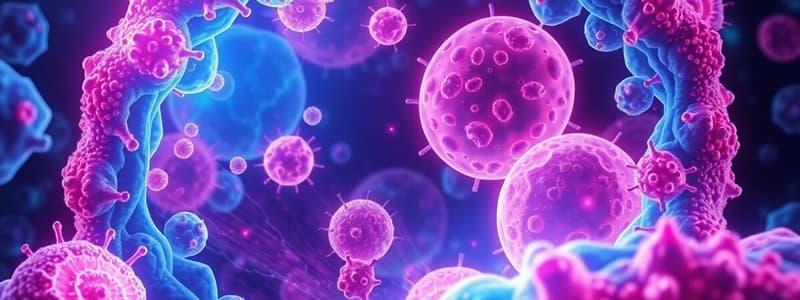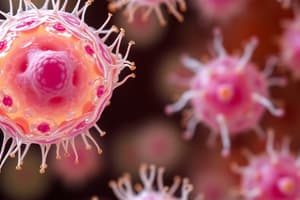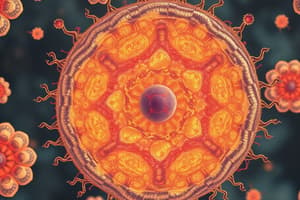Podcast
Questions and Answers
What distinguishes eukaryotic cells from prokaryotic cells?
What distinguishes eukaryotic cells from prokaryotic cells?
- The presence of ribosomes
- The absence of a cell wall
- The presence of a nucleus (correct)
- The absence of a plasma membrane
Which of the following organelles is NOT involved in the manufacture, distribution, or breakdown of molecules?
Which of the following organelles is NOT involved in the manufacture, distribution, or breakdown of molecules?
- Mitochondria (correct)
- Lysosomes
- Endoplasmic reticulum
- Golgi apparatus
What is the primary function of the cytoskeleton in eukaryotic cells?
What is the primary function of the cytoskeleton in eukaryotic cells?
- Producing energy
- Synthesizing proteins
- Storing genetic information
- Providing structural support and facilitating movement (correct)
How do the internal membranes of eukaryotic cells contribute to their functionality?
How do the internal membranes of eukaryotic cells contribute to their functionality?
Which of the following best describes the role of enzymes in eukaryotic cell metabolism?
Which of the following best describes the role of enzymes in eukaryotic cell metabolism?
Which of the following features is present in both prokaryotic and eukaryotic cells?
Which of the following features is present in both prokaryotic and eukaryotic cells?
What is the main difference between prokaryotic and eukaryotic ribosomes?
What is the main difference between prokaryotic and eukaryotic ribosomes?
Which of the following is a characteristic of prokaryotic cells, but not eukaryotic cells?
Which of the following is a characteristic of prokaryotic cells, but not eukaryotic cells?
What is the function of the bacterial flagella?
What is the function of the bacterial flagella?
Which of the following statements accurately describes the structure of the nucleoid in prokaryotic cells?
Which of the following statements accurately describes the structure of the nucleoid in prokaryotic cells?
The fluid mosaic model describes the plasma membrane as a dynamic structure. What characteristic contributes most to this fluidity?
The fluid mosaic model describes the plasma membrane as a dynamic structure. What characteristic contributes most to this fluidity?
A molecule easily crosses the plasma membrane without the help of a membrane protein. This molecule is most likely:
A molecule easily crosses the plasma membrane without the help of a membrane protein. This molecule is most likely:
Membrane proteins that facilitate the movement of specific molecules across the membrane are called:
Membrane proteins that facilitate the movement of specific molecules across the membrane are called:
Which of the following is NOT a function of membrane proteins?
Which of the following is NOT a function of membrane proteins?
What is the main driving force behind diffusion?
What is the main driving force behind diffusion?
Why is passive transport considered "passive"?
Why is passive transport considered "passive"?
Which of the following molecules can easily diffuse across the phospholipid bilayer of a cell membrane?
Which of the following molecules can easily diffuse across the phospholipid bilayer of a cell membrane?
How does the phospholipid bilayer contribute to the selective permeability of the cell membrane?
How does the phospholipid bilayer contribute to the selective permeability of the cell membrane?
Which of the following statements accurately describes the relationship between diffusion and concentration gradients?
Which of the following statements accurately describes the relationship between diffusion and concentration gradients?
During cellular respiration, which molecule accepts electrons at the bottom of the electron transport chain?
During cellular respiration, which molecule accepts electrons at the bottom of the electron transport chain?
What is the primary function of NAD+ in cellular respiration?
What is the primary function of NAD+ in cellular respiration?
What is the primary reason cellular respiration is considered a controlled process?
What is the primary reason cellular respiration is considered a controlled process?
What is the role of dehydrogenase enzymes in cellular respiration?
What is the role of dehydrogenase enzymes in cellular respiration?
What is the relationship between oxidation and reduction in cellular respiration?
What is the relationship between oxidation and reduction in cellular respiration?
Which of the following molecules is a primary fuel source for cellular respiration?
Which of the following molecules is a primary fuel source for cellular respiration?
What is the significance of the electron transport chain in cellular respiration?
What is the significance of the electron transport chain in cellular respiration?
Why is the heat released during cellular respiration important for animals?
Why is the heat released during cellular respiration important for animals?
What is the main difference between the energy release in burning sugar and in cellular respiration?
What is the main difference between the energy release in burning sugar and in cellular respiration?
What is the role of ATP in cells?
What is the role of ATP in cells?
Which of the following is the most accurate statement about the relationship between photosynthesis and cellular respiration?
Which of the following is the most accurate statement about the relationship between photosynthesis and cellular respiration?
Why is the statement "Plant cells perform photosynthesis, and animal cells perform cellular respiration" misleading?
Why is the statement "Plant cells perform photosynthesis, and animal cells perform cellular respiration" misleading?
Which of the following best describes the relationship between breathing and cellular respiration?
Which of the following best describes the relationship between breathing and cellular respiration?
Flashcards
Prokaryotic Cells
Prokaryotic Cells
Cells lacking a membrane-enclosed nucleus and organelles; found in Bacteria and Archaea.
Eukaryotic Cells
Eukaryotic Cells
Cells with a membrane-enclosed nucleus and organelles; all organisms except bacteria and archaea.
Ribosomes
Ribosomes
Cell structures made of RNA and protein; sites of protein synthesis in the cytoplasm.
Plasma Membrane
Plasma Membrane
Signup and view all the flashcards
Nucleoid
Nucleoid
Signup and view all the flashcards
Capsule
Capsule
Signup and view all the flashcards
Nucleus
Nucleus
Signup and view all the flashcards
Organelles
Organelles
Signup and view all the flashcards
Endoplasmic Reticulum (ER)
Endoplasmic Reticulum (ER)
Signup and view all the flashcards
Fluid Mosaic Model
Fluid Mosaic Model
Signup and view all the flashcards
Phospholipids
Phospholipids
Signup and view all the flashcards
Selective Permeability
Selective Permeability
Signup and view all the flashcards
Hydrophilic
Hydrophilic
Signup and view all the flashcards
Lipid Bilayer
Lipid Bilayer
Signup and view all the flashcards
Phospholipid Bilayer
Phospholipid Bilayer
Signup and view all the flashcards
Passive Transport
Passive Transport
Signup and view all the flashcards
Diffusion
Diffusion
Signup and view all the flashcards
Concentration Gradient
Concentration Gradient
Signup and view all the flashcards
Photosynthesis
Photosynthesis
Signup and view all the flashcards
Cellular Respiration
Cellular Respiration
Signup and view all the flashcards
Energy Flow in Ecosystems
Energy Flow in Ecosystems
Signup and view all the flashcards
Breathing vs. Cellular Respiration
Breathing vs. Cellular Respiration
Signup and view all the flashcards
Recycling of Matter
Recycling of Matter
Signup and view all the flashcards
ATP
ATP
Signup and view all the flashcards
Exergonic Process
Exergonic Process
Signup and view all the flashcards
Oxidation
Oxidation
Signup and view all the flashcards
Reduction
Reduction
Signup and view all the flashcards
Redox Reaction
Redox Reaction
Signup and view all the flashcards
NADH
NADH
Signup and view all the flashcards
Electron Transport Chain
Electron Transport Chain
Signup and view all the flashcards
Dehydrogenation
Dehydrogenation
Signup and view all the flashcards
Proton Gradient
Proton Gradient
Signup and view all the flashcards
Study Notes
Prokaryotic vs Eukaryotic Cells
- Prokaryotic cells evolved first, dominating Earth for over 1.5 billion years.
- Eukaryotic cells evolved from prokaryotic cells around 1.8 billion years ago.
- Prokaryotic cells are simpler and smaller than eukaryotic cells.
- Eukaryotic cells have a nucleus and other membrane-bound organelles.
- Both cell types have a plasma membrane, cytosol, chromosomes, and ribosomes.
- Prokaryotic cells do not have a nucleus or other membrane-bound organelles.
Prokaryotic Cell Structure
- DNA is coiled into a nucleoid region, not surrounded by a membrane.
- Prokaryotic ribosomes are smaller than eukaryotic ribosomes.
- Most have a rigid cell wall outside the plasma membrane.
- Some have a sticky capsule that helps them adhere to surfaces.
- Some have flagella for movement.
- May possess fimbriae for attachment.
Eukaryotic Cell Structure
- Organelles are membrane-bound compartments.
- Nucleus houses the cell's DNA, organized into chromosomes.
- Ribosomes are sites of protein synthesis, either free in cytoplasm or bound to the rough ER.
- Endoplasmic Reticulum (ER) produces proteins, lipids, and membrane components.
- Rough ER has ribosomes attached, for protein export.
- Smooth ER lacks ribosomes, synthesizes lipids and detoxifies substances.
- Golgi apparatus processes, sorts, and ships proteins or lipids.
- Lysosomes contain digestive enzymes.
- Vacuoles store and transport materials (central vacuole in plants, contractile vacuoles in protists).
- Mitochondria generate ATP; Chloroplasts, convert solar energy in plants/algae, are also part of the endomembrane system.
- Cytoskeleton provides structural support, movement, and internal organization, Composed of proteins.
Nucleus
- Contains the cell's genetic instructions (DNA).
- DNA is organized into chromosomes, visible during cell division.
- Nucleolus is a site of rRNA synthesis and ribosome production.
- Nuclear envelope controls passage of materials in and out of the nucleus (with pores).
- Chromatin is the complex of DNA and proteins when the cell isn't dividing.
Endomembrane System
- Connected network of membranes (nuclear envelope, ER, Golgi, lysosomes, vacuoles, and plasma membrane).
- Modifies, sorts, and ships proteins or lipids with further processing/packaging.
- Produces proteins, lipids, and membrane components.
Ribosomes
- Cellular protein factories, synthesize proteins, either free in cytoplasm or bound to the rough ER.
- Free ribosomes synthesize proteins for use in the cytosol, while bound ribosomes make proteins to be exported or incorporated into the endomembrane system.
- Ribosomes are structurally identical, but function differently depending on their location.
Mitochondria
- Generate ATP through cellular respiration.
- Have two membranes (outer and inner).
- Inner membrane has folds called cristae, increasing surface area for ATP synthesis.
- Contain their own DNA and ribosomes (evidence supporting the endosymbiotic theory).
Chloroplasts
- Carry out photosynthesis in plants and algae.
- Have two membranes (outer and inner).
- Thylakoids are the site of chlorophyll and light-capturing reactions, are stacked into grana.
- Stroma is the fluid surrounding the thylakoid sacs.
- Contain their own DNA and ribosomes (evidence supporting the endosymbiotic theory).
Lysosomes
- Membrane-bound organelles containing digestive enzymes.
- Break down and recycle damaged organelles, excess materials, or engulfed substances for cellular recycling.
Vacuoles
- Membrane-bound sacs for storage, transport, or elimination of materials.
- Central vacuole in plants stores water and maintains turgor pressure.
- Contractile vacuoles in protists regulate water content.
Peroxisomes
- Contain enzymes for detoxification of harmful substances (hydrogen peroxide).
- Important for various metabolic processes (lipid metabolism).
Other
- Cytoskeleton provides structural support, movement, and internal organization, composed of proteins.
- Cell walls provide support and protection (plant and fungi cells).
- Prokaryotic cells may have flagella for movement, fimbriae for attachment, and a capsule.
- Eukaryotic cells may have cilia or flagella for movement.
Studying That Suits You
Use AI to generate personalized quizzes and flashcards to suit your learning preferences.




